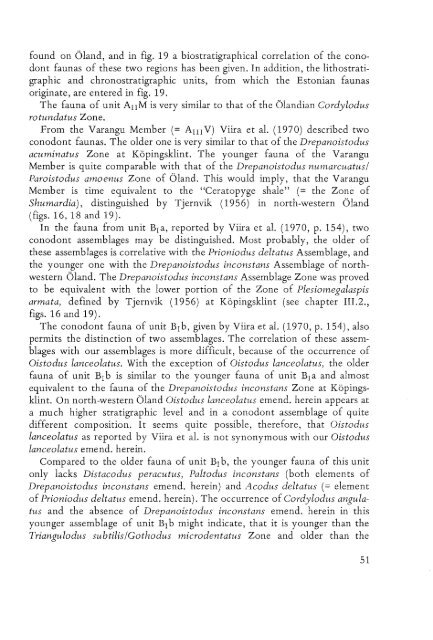UTRECHT MICROPALEONTOLOGICAL BUllETINS
UTRECHT MICROPALEONTOLOGICAL BUllETINS
UTRECHT MICROPALEONTOLOGICAL BUllETINS
You also want an ePaper? Increase the reach of your titles
YUMPU automatically turns print PDFs into web optimized ePapers that Google loves.
found on bland, and in fig. 19 a biostratigraphical correlation of the conodont<br />
faunas of these two regions has been given. In addition, the lithostratigraphic<br />
and chronostratigraphic units, from which the Estonian faunas<br />
originate, are entered in fig. 19.<br />
The fauna of unit ArrM is very similar to that of the 6landian Cordylodus<br />
ro tundatus Zone.<br />
From the Varangu Member (= AmV) Viira et al. (1970) described two<br />
conodont faunas. The older one is very similar to that of the Drepanoistodus<br />
acuminatus Zone at Kopingsklint. The younger fauna of the Varangu<br />
Member is quite comparable with that of the Drepanoistodus numarcuatus/<br />
Paroistodus amoenus Zone of bland. This would imply, that the Varangu<br />
Member is time equivalent to the "Ceratopyge shale" (= the Zone of<br />
Shumardia), distinguished by Tjernvik (1956) in north-western bland<br />
(figs. 16, 18 and 19).<br />
In the fauna from unit Bra, reported by Viira et al. (1970, p. 154), two<br />
conodont assemblages may be distinguished. Most probably, the older of<br />
these assemblages is correlative with the Prioniodus deltatus Assemblage, and<br />
the younger one with the Drepanoistodus inconstans Assemblage of northwestern<br />
bland. The Drepanoistodus inconstans Assemblage Zone was proved<br />
to be equivalent with the lower portion of the Zone of Plesiomegalaspis<br />
armata, defined by Tjernvik (1956) at Kopingsklint (see chapter m.2.,<br />
figs. 16 and 19).<br />
The conodont fauna of unit Brb, given by Viira et al. (1970, p. 154), also<br />
permits the distinction of two assemblages. The correlation of these assemblages<br />
with our assemblages is more difficult, because of the occurrence of<br />
Oistodus lanceolatus. With the exception of Oistodus lanceolatus, the older<br />
fauna of unit Brb is similar to the younger fauna of unit Bra and almost<br />
equivalent to the fauna of the Drepanoistodus inconstans Zone at Kopingsklint.<br />
On north-western bland Oistodus lanceolatus emend. herein appears at<br />
a much higher stratigraphic level and in a conodont assemblage of quite<br />
different composition. It seems quite possible, therefore, that Oistodus<br />
lanceolatus as reported by Viira et al. is not synonymous with our Oistodus<br />
lanceolatus emend. herein.<br />
Compared to the older fauna of unit Brb, the younger fauna of this unit<br />
only lacks Distacodus peracutus, Paltodus inconstans (both elements of<br />
Drepanoistodus inconstans emend. herein) and Acodus deltatus (= element<br />
of Prioniodus deltatus emend. herein). The occurrence of Cordylodus angulatus<br />
and the absence of Drepanoistodus inconstans emend. herein in this<br />
younger assemblage of unit Brb might indicate, that it is younger than the<br />
Triangulodus subtilis/Gothodus microdentatus Zone and older than the
















